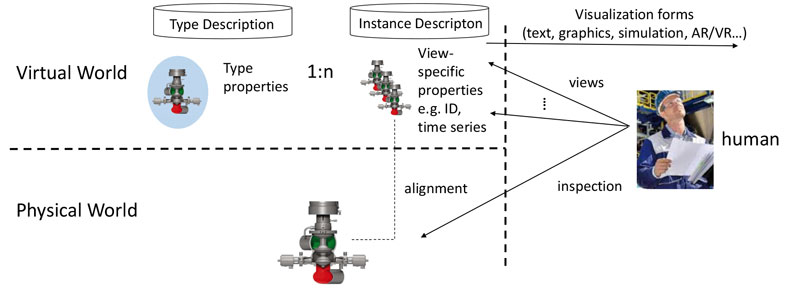by Thomas Usländer (Fraunhofer IOSB)
Representing real world objects as digital models has been a central topic of computer science for many years. However, in order to reduce the complexity and owing to the memory and processing limitations of IT devices, the digital models have always been quite tightly focused. Digital Twins (DT) are about to change this. The DT concept conveys the idea that digital representations should possess many of the essential properties of their real-world counterparts along their whole lifetime and even before and beyond. We propose an engineering methodology that allows an engineer to systematically motivate and derive these properties from use cases, and to deploy a DT as an interacting component in IIoT platforms.
First of all, the term digital twin is misleading. Although biological twins exhibit many genetic matches and start from a common environment, they evolve and socialise largely autonomously and independently of each other, at least with increasing age. Conversely, the “socialisation” and lifetime of a DT, especially in a digital factory, is basically independent of that of its real-world counterpart. Instead, the properties that are required depend upon the use cases and their associated lifetime phase of the DT as described below.
In design and engineering departments, digital representations of physical assets are created in virtual environments which are becoming ever closer to reality. A robot arm may be simulated in its cooperation with other robot arms or humans and optimised in its behaviour even before the physical robot arm is produced and installed.
In production environments, the ideal DT should comprise an exact image of all the properties and functions of the physical component (e.g. a robot arm or a pressure sensor), synchronised in (near) real-time throughout its life. Winding time back and forth would enables analysts to evaluate past situations and simulate future scenarios by means of prognostic models. Furthermore, an operation upon a DT should instantly affect the physical component and vice versa. Today’s technologies such as embedded sensors, the Industrial Internet of Things (IIoT) [1], efficient machine-to-machine (M2M) communication as well as cost-efficient and scalable data storage seem to make this type of synchronisation possible.
Long after the life of the physical object has come to an end, e.g. due to wear or dismantling, the DT may still exist, however, the archiving may be restricted to those properties that have a long-lasting value for documentation purposes.
All these use cases require different sets of DT properties that may, however, be expressed as different views upon an overarching set of properties.
There is a huge problem of DT interoperability when linking use cases and, hence, DT views and DTs among themselves. The digital model of an operating machine in a production control system, in addition to identification data, comprises only those machine status and operational data which are relevant for an operator. Engineering data describing type and geometry are typically not accessible or directly usable for production control systems. Incompatible IT systems and data models as well as different semantics hinder integrated industrial analytics and DT property value exchange.
In order to overcome these interoperability problems DTs need to follow standards (e.g. agreed property definitions and thesauri such as the cross-industry master-data ISO/IEC standard eCl@ss for products and services) and a dedicated engineering methodology. DTs shall be designed and implemented as reusable software components (e.g. Industrie 4.0 components [2]) being deployed in IIoT platforms and made accessible via interaction protocols and services based upon international standards [3]. Industry 4.0 components comprise an asset administration shell (AAS) and its asset counterparts, and are deployed within an IIoT platform environment. The AAS distinguishes between sub-models that are determined by application domains, industrial sectors and their standards, and views that are defined by the functional and informational shell of those properties that are required by the intended use cases.
When engineering DT as I4.0 components, a two-sided approach is required. From top-down it is important to know which properties are required by which use case. From bottom-up it is essential to know which I4.0 components are already specified or deployed in IIoT platforms and may be reused or refined. Fraunhofer IOSB provides a methodology known as SERVUS (service-oriented design of information systems based upon use case specifications) which supports such a two-sided analysis and design methodology and implements it in a Web-based collaborative platform engineering information system [4]. SERVUS allows an analyst to specify and document use cases as semi-structured tables, break them down into requirements of I4.0 components and map them in an agile manner to specified capabilities of I4.0 components of existing and emerging IIoT platforms. It helps to mediate between the possibly conflicting demands of users, product managers, software engineers and technology experts. The SERVUS methodology is indispensable for engineering interoperable digital twins to be deployed in IIoT platform environments.

Figure 1: Basic Concept of a Digital Twin (simplified). © 2018 Usländer, Fraunhofer IOSB.

Figure 2: Dashboard of the IIoT Platform Engineering Information System based upon SERVUS. © 2018 Usländer, Fraunhofer IOSB.
References:
[1] J. Beyerer, T Usländer (Eds.): “Special Issue: Industrial Internet of Things supporting Factory Automation”. Bd. 64.9. at Automatisierungstechnik. 2016.
[2] IEC PAS 63088:2017 Smart manufacturing—Reference architecture model industry 4.0 (RAMI4.0). see also DIN SPEC 91345:2016-04, April 2016.
[3] DIN SPEC 16593-1:2018-04 Reference model for Industrie 4.0 Service Architectures (RM-SA) – Part 1: Basic concepts of an Interaction-based Architecture. April 2018. https://kwz.me/hdn
[4] Usländer, T.: “Agile Service-oriented Analysis and Design of Industrial Internet Applications”, in Proc. of CIRP-CMS 2016, Elsevier.
Link: https://kwz.me/hdN
Please contact:
Thomas Usländer
Fraunhofer IOSB, Germany
+49 721 6091 480











